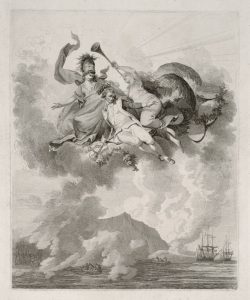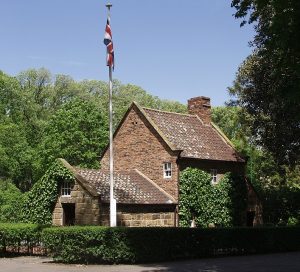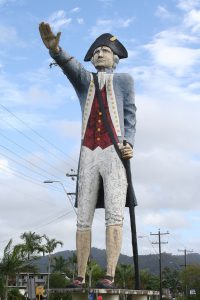5 Cook, and his place in the Australian imagination
James Cook’s name and image are familiar to most Australians. He is present in the title of this work, and in the name of the institution that supports it. Yet despite the prominence given to Cook in Australia, he visited the continent only briefly. He returned to Aotearoa (New Zealand) more often than to Australia, and he spent much more time there. Cook is remembered in Aotearoa, but is not considered the island group’s European discoverer, and his legacy is debated in historical terms. In Australia, Cook’s cultural significance is different for different groups of Australians: to some he is a founding hero, to others he marks the start of an invasion. Both interpretations have spread well beyond the limits of his actual presence on the continent and highlight the way in which his imaginative presence on the Australian continent is far greater than his physical presence ever was.

Cook’s encounter with the Australian continent during his lifetime was limited. He travelled north along the east coast of the continent in 1770, and named the coastline he mapped New South Wales. He was the first European to record the eastern edge of the Australian continent, and the western region retained the name New Holland until after the voyages of Matthew Flinders. Cook’s ship the Endeavour collided with what is now known as the Great Barrier Reef (a name later suggested by Flinders) and Cook and his crew spent seven weeks repairing his ship in what is now the far north of the state of Queensland. Cook recognised his good fortune in being able to repair his ship, make his way through the rest of the reef, and escape Australian shores. He returned briefly to what is now considered Australia when he visited the island now called Tasmania on his third voyage to the Pacific. By 1786, when the British government made the decision to establish a penal colony on the coast mapped by Cook, Cook was already dead. He had been killed in Hawai’i in 1779 and as a result was unable to offer advice to the British government on its plans for colonising New South Wales.

Despite Cook’s limited contact with Australia, the continent is home to many memorials to him. Some of those memorials are of questionable authenticity, such as Captain Cook’s cottage in Fitzroy Gardens, Melbourne. The cottage was painstakingly transported from the United Kingdom in 1934, and reassembled with attention to authenticity that extended to the plants climbing its walls. However, Cook never lived in the cottage (he may have visited his parents when they lived there), and he never visited the region that is now Victoria. Other Australian Cook monuments are large and startling, such as the privately-owned, 8m-tall, fibreglass Captain Cook that graced the streets of Cairns between 1972 and 2022. Canada, Aotearoa, Britain, and the United States of America (particularly the state of Hawai’i) are also home to Cook memorials, but those memorials tend to be more closely linked to places visited or frequented by Cook during his life.

Australia’s Cook memorials reflect the ways in which Cook has become an important figure in popular Australian history. Spanish encounters with Australia occurred before Cook’s visit, and the Dutch mapped substantial portions of the north and west coasts. These European contacts with the Australian continent are not associated with the founding of the nation of Australia in the same way as Cook’s comparatively brief visit. Even the Englishman William Dampier’s visits to the continent in 1688 and 1699 fail to feature in national mythologising about Australian origins. Settler Australia tends to seek its origins in 1770 and the Endeavour voyage, despite the brevity of the visit and Cook’s lack of enthusiasm for returning to the region. In the present, Cook’s only competition as the founder-hero of the Australian nation comes from the legendary Anzacs.
Historical assessments of Cook have gathered pace since the 1960s. While his skills in navigation and cartography remain lauded, his interactions with the local people he encountered during his travels have been reassessed. He is generally considered to have attempted to behave humanely, but since the 1960s there has been growing recognition of violent interactions between Cook and the traditional owners of the places he visited, of his misbehaviour (through cultural ignorance or because of perceived threats to his ships or crews), of his failings as a captain on his third Pacific voyage, and of Cook’s own deliberate violence towards members of his crew and Islanders who committed acts he considered crimes. These reassessments of Cook also include appreciation that his legacy lies in the accurate maps he produced of the Pacific, and in his facilitation of the work of scientists travelling with him. Rather than locating places completely unknown to Europeans, Cook eliminated phantom islands and continents, and competently mapped islands that had been glimpsed by earlier explorers. Cook’s talent was in pinning places to the map and making it possible for Europeans to revisit them at will.
Anthropologist Deborah Bird Rose has found that Cook is an important figure in Aboriginal stories about the establishment of settler Australia, even in parts of the country that Cook never visited. Stories from a wide range of places in northern Australia, including the Kimberley, Arnhem Land and Queensland feature Cook as a villain. Like the national myths of European Australians, these stories hold Cook responsible for the arrival of settler colonialism in Australia. And like the stories told by Australians of European descent, these stories have Cook actively involved in the establishment of European settlement in Australia.
Cooktown, located in far north Queensland, actively promotes itself as the place where Cook spent most time while in Australia. It is visited by tourists drawn by its name and history. The heritage efforts of the town are an interesting reflection on Cook’s significance. While the town trades on Cook, it also promotes other forms of heritage including Aboriginal culture, the history of Aboriginal engagement with the Endeavour’s crew, and a multicultural past that highlights Chinese gold miners drawn to the Palmer River goldfield. The promotion of this array of heritage elements, including the possibility of reconciliation both in the past and in the present as represented by an incident that occurred during Cook’s visit, is a sign of the way in which Cook still looms large in the Australian imagination. In many ways, Cooktown is creating the heritage that Australia needs for an inclusive and diverse future, but without challenging the significance of Cook as a foundational figure for Australia.
Captain Cook looms large in European exploration of the Pacific. While he discovered few places that were entirely new to Europe, his voyages came at the time when technological developments were changing the ways in which Europeans navigated and recorded the region. He made contributions to European cartography, and other quickly evolving sciences including astronomy and biology. Captain Cook also became a myth. His time in Australia allowed him to be perceived as the founding father of the nation that emerged from European settler colonialism on the continent. The actions of the historical Cook are in some ways insignificant in comparison to his roles as a national icon and a clear founding moment for the Australian nation that was formed in 1901.
Links
Explorer Journals
Cook, James. Captain Cook’s Journal During his First Voyage Round the World Made in H. M. Bark “Endeavour” 1768-71. London: Elliot Stock, 1893. https://www.gutenberg.org/files/8106/8106-h/8106-h.htm
Cook, James. A Voyage Towards the South pole, and Round the World. Performed in His Majesty’s Ships the Resolution and Adventure, in the Years, 1772, 1773, and 1775, volume 1. London: W. Strahan & T. Cadell, 1777. https://open.library.ubc.ca/collections/chung/chungpub/items/1.0129127
Cook, James. A Voyage Towards the South pole, and Round the World. Performed in His Majesty’s Ships the Resolution and Adventure, in the Years, 1772, 1773, and 1775, volume 2. London: W. Strahan & T. Cadell, 1777. https://open.library.ubc.ca/collections/chung/chungpub/items/1.0129126?o=1
Cook, James. The Three Voyages of Captain James Cook Round the World Complete in Seven Volumes, Vol V. Being the First of the Third Voyage. London: Longman, Hurst, Rees, Orme, and Brown, 1821. https://www.gutenberg.org/ebooks/62095
Cook, James. The Three Voyages of Captain James Cook Round the World Complete in Seven Volumes, Vol VI. Being the Second of the Third Voyage. London: Longman, Hurst, Rees, Orme, and Brown, 1821. https://www.gutenberg.org/ebooks/62507
Cook, James. The Three Voyages of Captain James Cook Round the World Complete in Seven Volumes, Vol VII. Being the Third of the Third Voyage. London: Longman, Hurst, Rees, Orme, and Brown, 1821. https://www.gutenberg.org/ebooks/62659
Turnbull, Paul, Chris Blackall, National Library of Australia and Australian National University. “South Seas: Voyaging and Cross Cultural Encounters in the Pacific (1760-1800).” Archived 16 February 2011. National Library of Australia, Trove. https://webarchive.nla.gov.au/awa/20110215214918/http://southseas.nla.gov.au/index.html
Maps and online resources
Captain Cook Society, Australia. “[List of Cook memorials worldwide].” Accessed March 31, 2022.
Video Material
Open access secondary sources
Antonello, Alessandro. “Memorialising Captain Cook in Lonely Places.” Inside Story, September 2, 2020. https://insidestory.org.au/memorialising-captain-cook-in-lonely-places/
Rose, Deborah Bird. “Ned Kelly Died for Our Sins.” Oceania 65, no. 2 (1994): 175–86. http://www.jstor.org/stable/40331430
Subin, Anna Della. “How to Kill a God: The Myth of Captain Cook Shows How the Heroes of Empire Will Fall.” Guardian, January 18, 2022. https://www.theguardian.com/news/2022/jan/18/how-to-kill-a-god-captain-cook-myth-shows-how-heroes-of-empire-will-fall

